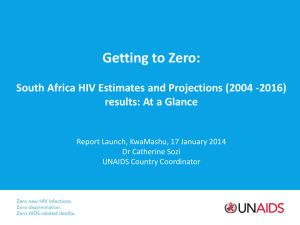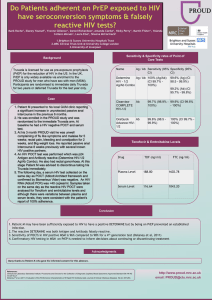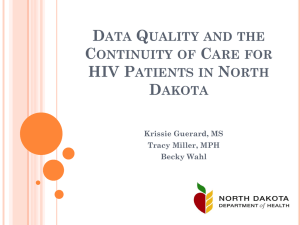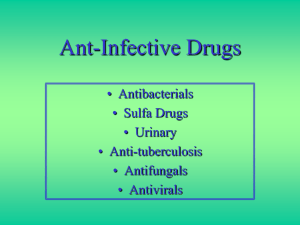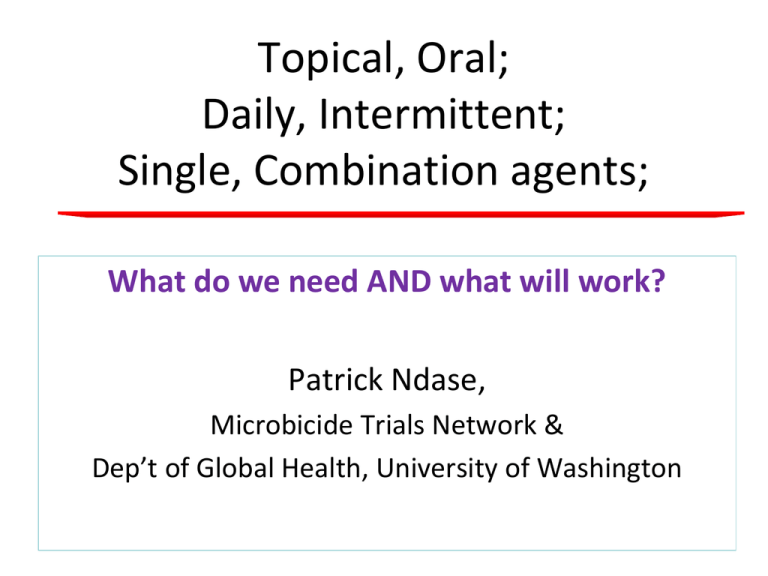
Topical, Oral;
Daily, Intermittent;
Single, Combination agents;
What do we need AND what will work?
Patrick Ndase,
Microbicide Trials Network &
Dep’t of Global Health, University of Washington
THE BOLD STATEMENT
Within the research & advocacy community,
there is a lot of enthusiasm & hope around the
promise of ARV-based approach to HIV
prevention
– Biomedical piece that will likely revolutionalize HIV
prevention
WE NEED
• Topical AND Oral ARV-based intervention
– Know your HIV status = Know your options
• Daily dosing as a 1st step but Intermittent
dosing based on exposure times preferred
• Single agents if efficacious & out of treatment
realm desired, but the search for combination
agents ought to continue
Key stakeholders’ question has been…….
• How can you explain the enthusiasm
around ARV based prevention, amidst
ever diminishing slots for people in
desperate need of care?
– Shall funders have the much needed
momentum for prevention in light of failed
sustained momentum for treatment?
– Can’t the biomedical prevention approach be
mismanaged?
Reminder of why we need
additional prevention tools now
For every 2 people started on ART in Southern Africa,
3 become newly infected
In South Africa alone
• >1500 new HIV infections are Estimated to occur daily
• An approx 70,000 babies are born with HIV annually
Bottom line:
We need to prevent new infections if we’re to effectively
treat those who need care.
http://www.avert.org/aidssouthafrica.htm
The Face of HIV in Uganda
• 110,000 new infections every year
(> 300 new infections everyday)
• 73,000 (66%) of new infections
annually are women.
• 47% of the women living with
advanced have no access to antiretroviral therapy
• 52% percent access PMTCT (21%
of new infections due to MTCT)
The New York Times on Uganda
At Front Lines, AIDS War Is Falling Apart
• ~ 500,000 need
treatment
• 200,000 getting
treatment
• Each year approx
an additional
110,000 infected
HIV slots not only limited to Uganda
• Economy Hurts Government Aid for H.I.V. Drugs,
New York Times of June 30th, 2010
FORT LAUDERDALE, Fla. Nearly 1,800 have been relegated to rapidly expanding
waiting lists that less than three years ago had dwindled to zero.
http://www.nytimes.com/2010/07/01/us/01aidsdrugs.html?hp
Proving the skeptics wrong
• ART roll-out in resource limited settings
will never be possible
– Countries now constrained with stock-outs & few slots
for new entrants
• Adherence to ART will be poor in the
developing world
– Some of highest reported adherence rates
– Resistance a major worry due to programmatic failure
(NOT poor adherence)
Signal of willingness to access
prevention services
Documented HIV Prevalence on Island is 17% [2006 Sentinel survey]
• Having sex is single most important risk factor in context of high prevalence
Up to 5hrs en-route study clinic for PrEP
• Participants wake up 3:00AM to start journey
• Yet with excellent retention
Topical, Oral;
Daily, Intermittent;
Single, Combination agents;
What do we need AND what will work?
Is the field poised to provide all we need?
HSV-2
Treatment Infectiousness
Index Partner
Treatment
Vaccine Prime/Boost
Thailand
Vaccine - DNA
Prime/Ad5 Boost
US
Microbicide BufferGel,
PRO2000
CAPRISA 004
Oral TDF &
Truvada &
Tenofovir gel VOICE
Oral Truvada MSM (iPrEx)
Oral Truvada –
Heterosexual
Botswana
Oral TDF - IDU
Thailand
2009
New
Vaccine
concept(s)
Microbicide Dapivirine
gel & ring
TDF Gel
Microbicide PRO2000
Oral TDF -MSM
US (Ph II)
Testing &
linkage to care
plus (TLC+)
2010
Oral TDF,
Truvada Partners PrEP
Oral Truvada FemPrEP
TMC 278 UK (Ph I/II)
2011+
2015+
KEY
Treatment as PX
Vaccines
Microbicides
PrEP
What will be lacking?
Topical / Oral
VOICE efficacy & acceptability data
will be critical
Daily / Intermittent
No data on intermittent use & efficacy
A hint from CAPRISA’s coitally
dependent approach
Single / Combination agents
Oral: TDF/Truvada will provide a hint
No topical combinations
The three issues here all point to efficacy;
QUESTION:
But how much of an impact does efficacy have on the epidemic?
The Prvention Cascade –
50% Access/Adherence
100 Women Exposed to HIV
(10% transmission risk)
Access to
Microbicides/
PrEP 50%
50 have
access
50 have no
access
TOTAL
Use Microbicides/
PrEP 50%
25 use
75 do not use
No Product −
10 infections
Product 50%
effective
1.3 infections
7.5
infections
If 50% −
9 infections
Product 80%
effective
0.5 infections
7.5
infections
If 80% −
8 infections
The Microbicide/PrEP Cascade –
95% Access/Adherence
100 Women Exposed to HIV
(10% transmission risk)
Access to
Microbicides/
PrEP 95%
95 have
access
5 have no
access
TOTAL
Use Microbicides/
PrEP 95%
90 use
10 do not use
No Product –
10 infections
Product 50%
effective
4.5 infections
1
infection
If 50% −
6 infections
Product 80%
effective
1.8 infections
1
infection
If 80% −
3 infections
The prevention Cascade
Intervention effect
Percent coverage
Fraction of Infections
prevented
80%
50%
20%
50%
95%
40%
The effectiveness of an intervention, matters but
coverage matters even more
Impact of ARV-based
prevention on epidemic
Modeling work (Imperial College London)
• Targeting most at-risk populations
• Extent of coverage of these populations
• Adherence/Acceptability of the interventions
An old challenge!
Can we deliver on the promise?
Estimates of Coverage
HIV testing
5%
Condom Use
Male Circumcision
Antiretrovirals for
PMTCT
20%
39%
80%
9% 15%
85%
10%
75%
25%
9%
Contraception for
PMTCT
Unmet Need for HIV Prevention
32%
14%
45%
55%
85%
15%
0%
20%
2004
40%
2006/7
60%
2008
80%
100%
Unmet HIV Prevention Need
Sources: UNAIDS, 2004; UNGASS, 2008; WHO, 2009
Thank You
The Microbicide Trials Network
The International Clinical Research Center at UW


